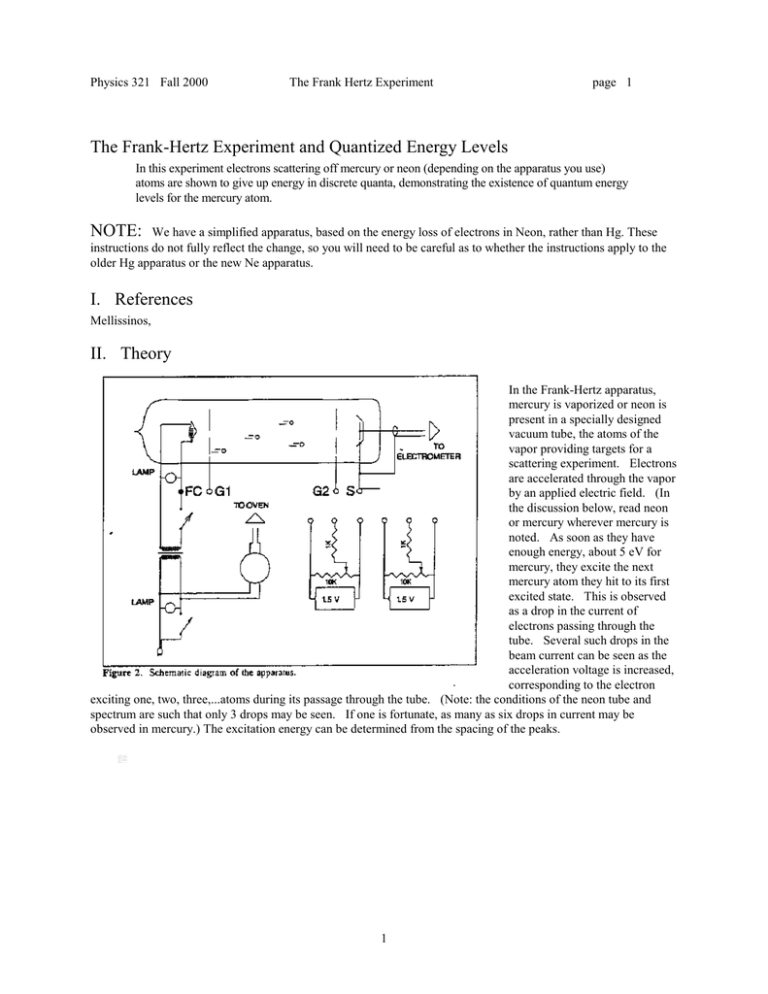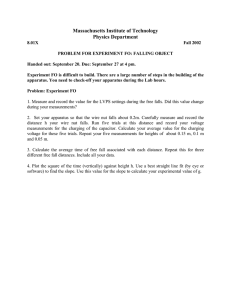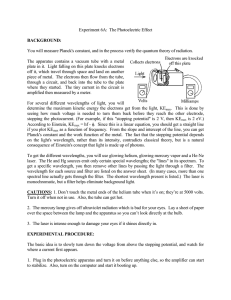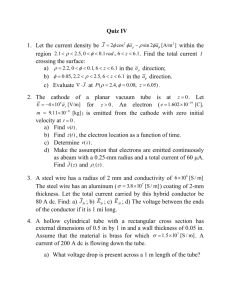5_Frank.doc
advertisement

Physics 321 Fall 2000 The Frank Hertz Experiment page 1 The Frank-Hertz Experiment and Quantized Energy Levels In this experiment electrons scattering off mercury or neon (depending on the apparatus you use) atoms are shown to give up energy in discrete quanta, demonstrating the existence of quantum energy levels for the mercury atom. NOTE: We have a simplified apparatus, based on the energy loss of electrons in Neon, rather than Hg. These instructions do not fully reflect the change, so you will need to be careful as to whether the instructions apply to the older Hg apparatus or the new Ne apparatus. I. References Mellissinos, II. Theory In the Frank-Hertz apparatus, mercury is vaporized or neon is present in a specially designed vacuum tube, the atoms of the vapor providing targets for a scattering experiment. Electrons are accelerated through the vapor by an applied electric field. (In the discussion below, read neon or mercury wherever mercury is noted. As soon as they have enough energy, about 5 eV for mercury, they excite the next mercury atom they hit to its first excited state. This is observed as a drop in the current of electrons passing through the tube. Several such drops in the beam current can be seen as the acceleration voltage is increased, corresponding to the electron exciting one, two, three,...atoms during its passage through the tube. (Note: the conditions of the neon tube and spectrum are such that only 3 drops may be seen. If one is fortunate, as many as six drops in current may be observed in mercury.) The excitation energy can be determined from the spacing of the peaks. 1 Physics 321 Fall 2000 The Frank Hertz Experiment page 2 The energy levels of the mercury atom are shown in figure 1 to the left. The lowest level is the ground state. The transition which we observe is from the ground state to one of the 3P states. While the details of how these energy levels arise may not be clear to you at the present time, the quantized nature of the transitions should be. III. Procedure Note: If one is doing the Neon experiment, steps A-D are ignored. One will follow similar procedures, but there is no oven to adjust, and the meter one uses is the laboratory digital multimeter, as the commercial apparatus has a built-in current amplifier for the electron current. In fact, we will just look at the Neon spectra dynamically, on an oscilloscope. A. The tube should be heated for a while before starting the experiment, preferably an hour or more. (Finding the right temperature to see the minima clearly is the most challenging part of this experiment! The variac should be set to 50 V (the higher of the two points marked). Put in 1.5-volt batteries for the two grid biases G1 and G2. (See the circuit diagram of figure 2.) Please remember to remove the batteries at the end of the session, or they will run down. Verify with a voltmeter that you can adjust G1 between 0 and +1.5 V relative to the cathode (FC), and G2 between 0 and +1.5 V relative to ground. Set them both initially to 1.5 V. B. Connect the Keithley electrometer. Connect the power supply from FC to G2 with G2 positive, and set it to 10 volts. You should measure a current of about 10 -6 A when the tube is cold, decreasing as it heats (why? –Your thoughts or speculations on this should be in your book, as should other questions that arise in your own mind. Don't be afraid to say something that is wrong. Rather, use the book to expand your thinking. ) to around 3x10-9 A when hot. C. Note how the beam current depends on the G1 bias voltage. G1 acts like a valve, to turn the beam off and on. You may find later on that smaller beam currents permit you to go to higher accelerating voltages without the tube sparking off. D. Sweep the accelerating voltage to a maximum of 40 V. Caution! A discharge may take place at some value of this voltage, causing a jump in the anode current. If this happens, turn the voltage down at once. E. Try to find a series of current troughs as you sweep the voltage. You may have to change the oven setting. The tube can easily be cooled by pulling it part way out of the oven. The general effect of raising the temperature is to accentuated the high-voltage troughs; cooling enhances the low-voltage troughs, but often loses some of the high-voltage troughs. But with this experiment, there are no fixed rules. What works best with one set-up may not work well at all with another. F. From part E. you should have an idea where the troughs are, and what the range of current you expect. Make a labeled set of axis in your laboratory book, and record current vs. accelerating voltage. The loss of energy experienced by the electrons when they excite the atoms will occur over a range. It is not really clear where the optimum point is to measure. Fluctuation in the heater voltage due to the IR drop as a function of position, for instance, adds a range of values of maximum energies of the electrons. Your objective is to measure the difference between corresponding parts of the absorption from minima to minima. You may wish to try two alternatives, 1) measurement of the position of the half height of the 2 Physics 321 Fall 2000 The Frank Hertz Experiment page 3 drop from just before the current drops to the minimum or 2) measurement of the bottom of each trough. To do either, you need detailed readings from the peak through the trough, and not at all detailed when you are not at a trough. For instance, if you measure the difference between trough minima, you will want to obtain data on either side of the minimum, and find the minimum as the average between corresponding points on the sides of the trough. Similarly, if you use the half-way down of the initial slope, you will want data at the peak and at the trough in order to estimate the location of the 1/2 height point. (With the Hg vapor tube, if you spend time taking data away from the troughs, you may find that the whole curve has shifted by the time you finish due to the changing temperature, and you will only obtain a lot of frustration.) When you mark the point on your graph, you can also record the values measured next to the point so that you do not lose any significant figures on the graph. Do a linear fit to determine the excitation energy and its error. The y-coordinate should be voltage, and the x-coordinate, peak number. The resulting slope determined by the fitting program is the peak spacing, in volts. Compare with values which will be supplied by the instructor. IV. Equipment Frank-Hertz apparatus laboratory digital voltmeter (For old Hg apparatus: Keithley 610-C electrometer 40-V power supply) 3






